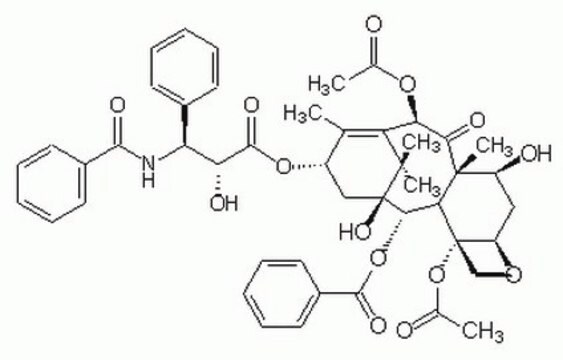APT800
Apoptosis Inducer Set
Apoptosis Inducer Set contains Actinomycin D, Camptothecin, Cycloheximide, Dexamethasone & Etoposide. These compounds can be used for inducing apoptotic activity in many cell culture systems.
Synonym(e):
5 Apotosis Inducers
About This Item
Empfohlene Produkte
Qualitätsniveau
Form
liquid
Speziesreaktivität (Voraussage durch Homologie)
mammals
Hersteller/Markenname
Chemicon®
Methode(n)
activity assay: suitable
Versandbedingung
dry ice
Allgemeine Beschreibung
Camptothecin: Powerful anti-tumor agent. Camptoethecin is an inhibitor of DNA-topoisomerase I. The drug activates the p53 resulting in upregulated expression of TRAIL-R2 (DR5) and Bak to overcome TRAIL resistance in Bax-deficient human colon carcinoma cancer cells. In addition, Camptoethecin induced apoptosis can be increased by the presence of cytokines such as TNF via its subsequent inhibition of NFkappa B {Valente P et al Eur J Cancer (2003) 39:1468-77}.
Cycloheximide: A potent protein translation inhibitor which results in the inhibition of protein synthesis and subsequent arrest of cell growth and induction of cell death. Cycloheximide also facilitates apoptosis induction via FasL, however, cycloheximide can also prevent apoptosis in some systems, such as thalassemic serum induction of HUVEC cells {Banjerdpong, R. (1998) Ph.D Thesis Mahidol Univ. Bangkok, Thailand}.
Dexamethasone: Classic inducer of apoptosis in thymocytes; a glucocorticoid anti-inflammatory agent. Regulates T cell survival, growth and differientiation; modulator of nitric oxide synthase. Induces apoptosis in thymocytes as well as other immune cells like microglia. However, like other apoptotic inducers, dexamethasone can suppress apoptosis in certain systems through the activation of anti-apoptotic proteins such as bcl-X {Chang, et al (1997) FEBS Letter 415:11-15}.
Etoposide: Potent topoisomerase II inhibitor. An anti-tumor agent that enhances dsDNA & ssDNA cleavage and inhibits DNA religation. Inhibits the cell cycle in the S-phase and induces apoptosis in normal and tumor cell lines, but can be modulated by intracellular levels of cAMP and other factors {Bermejo, L et al (1998) J. Cell Sci 111:637-644;Solovyyan, V et al. (1998) Brain Res Mol Brain Res 62:43-55}
Anwendung
Apoptose & Krebs
Komponenten
· Camptothecin (2 mM): 1 mL
· Cycloheximide (100 mM): 1 mL
· Dexamethasone (10 mM): 1 mL
· Etoposide (10 mM): 100 μL
Physikalische Form
Lagerung und Haltbarkeit
WARNING: Kit contains highly toxic agents; professional users only; wear gloves and other protective equipment and good laboratory practices when manipulating the concentrated and diluted solutions.
Rechtliche Hinweise
Haftungsausschluss
Signalwort
Danger
H-Sätze
Gefahreneinstufungen
Acute Tox. 3 Oral - Aquatic Chronic 3 - Carc. 1B - Muta. 1B - Repr. 1B
Lagerklassenschlüssel
6.1C - Combustible acute toxic Cat.3 / toxic compounds or compounds which causing chronic effects
Flammpunkt (°F)
188.6 °F
Flammpunkt (°C)
87 °C
Analysenzertifikate (COA)
Suchen Sie nach Analysenzertifikate (COA), indem Sie die Lot-/Chargennummer des Produkts eingeben. Lot- und Chargennummern sind auf dem Produktetikett hinter den Wörtern ‘Lot’ oder ‘Batch’ (Lot oder Charge) zu finden.
Besitzen Sie dieses Produkt bereits?
In der Dokumentenbibliothek finden Sie die Dokumentation zu den Produkten, die Sie kürzlich erworben haben.
Unser Team von Wissenschaftlern verfügt über Erfahrung in allen Forschungsbereichen einschließlich Life Science, Materialwissenschaften, chemischer Synthese, Chromatographie, Analytik und vielen mehr..
Setzen Sie sich mit dem technischen Dienst in Verbindung.










